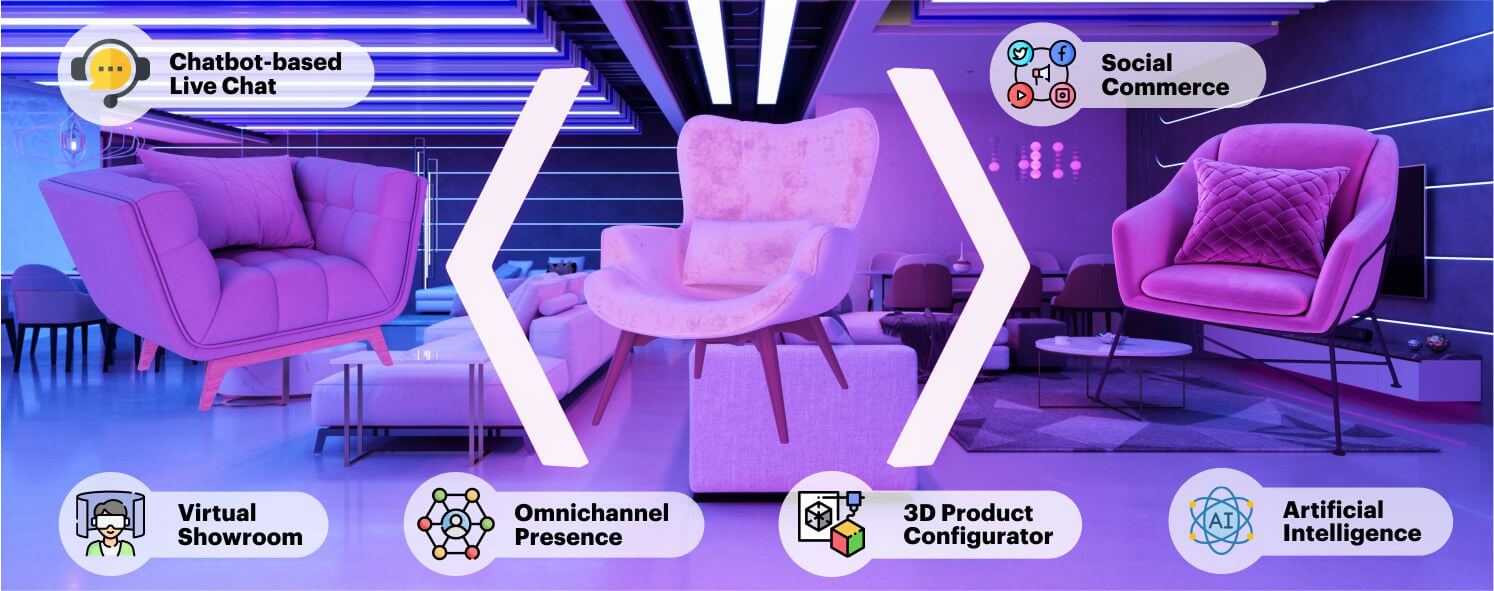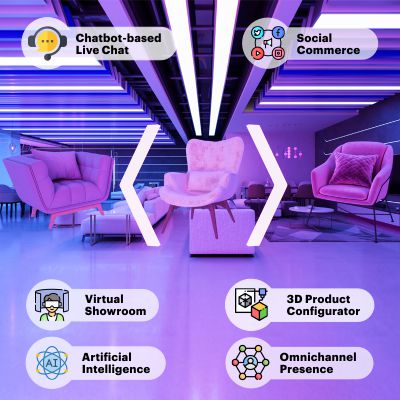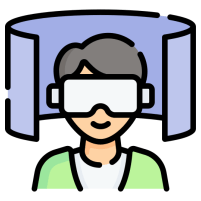Synopsis:
Technological advancement has given modern furniture websites an ample lot of options which can help them use these technologies as an advantage. These technologies are helping them reshape the online shopping experience.
This comprehensive guide explores these transformative technologies like AR, VR, and 3D product configurators are helping on online furniture websites. From chatbot-based live chats to immersive virtual showrooms, each feature is dissected to reveal its role in enhancing customer engagement and driving ROI.
Discover how these tools empower customers to personalise their shopping journey while positioning modern furniture websites as leaders in competitive online retail.

Introduction
Furniture has always been a unique contender in eCommerce. Unlike clothing or electronics, purchasing furniture online requires a deeper level of consideration. From measuring dimensions to visualizing how a piece fits within a space, the challenges were manifold.
However, with the advancement of technology, particularly the integration of Augmented reality (AR), Virtual reality (VR), and 3D product configurator, the furniture market has undergone a significant transformation.
Gone are the days when purchasing furniture meant hopping from one showroom to another, attempting to envision how a couch or a coffee table might complement your living room. Today’s modern furniture websites offer an immersive experience, blurring the lines between physical and digital shopping.
Augmented reality, 3D product configurators, virtual showrooms, etc. help enhance the way people interact with products and help them virtually place them in their own homes to get a realistic preview of how they will look and fit.
This blog will take you through the 6 features of furniture eCommerce stores that can aid in increasing your furniture website ROI.
6 Features of a Modern Furniture Websites
Knowing these 6 features of a modern furniture websites will help you know what’s trending in the market and how it can help your business thrive in the market.


1. Chatbot-based Live Chat
Chatbot-based live chat is an indispensable feature of modern furniture websites. It offers real-time assistance to customers navigating through product options and queries. Live chat facilitates instant communication with support representatives, providing personalised guidance and resolving concerns promptly.
Similarly, chatbots employ AI algorithms to simulate human-like interactions, offering round-the-clock assistance and smoothening customer service processes. These features improve the shopping experience on furniture websites.
It fosters customer’s trust in the brand. Whether it’s assistance with product specifications, shipping details, or general inquiries, a chatbot-based live chat helps customers receive the support they need, driving engagement and conversion rates on modern furniture websites.
2. 3D Product Configurator
A 3D product configurator revolutionizes the way customers interact with online furniture websites. It allows them to personalise and visualise products in immersive detail. Unlike traditional static images, this innovative tool enables users to customise furniture according to their preferences, altering dimensions, materials, colours, and finishes in real time.
By offering a dynamic and interactive experience, the 3D product configurator enables customers to create furniture to their unique tastes and requirements, enhancing engagement and satisfaction. Moreover, it mitigates the risk of mismatched expectations, as users can accurately preview how the customised piece will look and fit within their living spaces.
With its ability to provide a highly personalised shopping experience, the 3D product configurator is a game-changer for online furniture websites.
3. Omnichannel Presence
Omnichannel presence is crucial for modern furniture websites. This helps them ensure a seamless and cohesive shopping experience across multiple channels. It integrates various touchpoints like websites, mobile apps, social media platforms, and physical stores, to create a unified brand experience.
Customers can browse products online, engage with social media content, and make purchases both online and offline, with consistent branding and messaging throughout. By embracing omnichannel strategies, modern furniture websites can meet customers wherever they are in their purchasing journey, providing convenience and flexibility.
Whether a customer prefers to shop online, explore in-store, or engage with social media content, a cohesive omnichannel presence ensures that their experience remains consistent and cohesive, fostering trust and loyalty in the online furniture websites.

4. Social Commerce
Social commerce has emerged as a powerful strategy for modern furniture websites to engage with customers and drive sales directly through social media platforms. By utilising platforms like Instagram, Facebook, WhatsApp, X (formerly Twitter), and Pinterest, furniture websites can highlight their products in real-life settings, inspiring potential customers with visually appealing content.
Through shoppable posts and interactive features, such as product tags and swipe-up links, social commerce seamlessly integrates the shopping experience into the social media environment. Customers can discover products, read reviews, and make purchases without leaving their favourite social platforms.
Moreover, modern furniture websites can harness the power of user-generated content and influencer partnerships to expand their reach and build a community around their brand. With social commerce, furniture websites can tap into the vast potential of social media to drive traffic, increase conversions, and cultivate brand loyalty.

5. Artificial Intelligence
Undoubtedly, artificial intelligence (AI) is transforming the landscape of modern furniture websites. It is enhancing the shopping experience and driving conversions through personalised interactions and predictive analytics.
By analysing vast amounts of data, AI algorithms can create product recommendations and marketing messages to individual preferences, increasing relevance and engagement. Moreover, AI-powered chatbots provide instant assistance to customers, addressing queries and guiding them through the purchasing process in real time.
These intelligent systems simplify operations, automate repetitive tasks, and optimise inventory management, improving efficiency and reducing costs for furniture websites. Additionally, AI enables dynamic pricing strategies, allowing brands to adjust prices in response to demand and market conditions, maximizing profitability.
With its ability to deliver personalised experiences, optimize processes, and drive revenue, AI is an indispensable tool for modern furniture websites seeking to stay ahead among online furniture websites.

6. Virtual Showroom
A virtual showroom is an innovative digital platform that simulates the experience of a physical showroom online. It allows customers to explore and interact with furniture products through immersive 3D and sometimes VR technology.
Users can navigate through a virtual space, view furniture from multiple angles, experience different layouts, and even test design variations in real-time, all from the comfort of their homes.
This interactive experience not only helps customers visualise how items will look and fit in their spaces but also makes the shopping experience more engaging and informative. For furniture retailers, virtual showrooms offer a way to display their full range of products without the constraints of physical space, enhancing customer reach and engagement while minimizing overhead costs.
Modern furniture websites can leverage virtual showrooms to present their products in more aesthetic and fitting settings enabling customers to feel the products.
Why Furniture eCommerce Website Need 3D Product Configurator?
The conventional method of purchasing furniture online frequently left shoppers uncertain about their choices. Limited visualisation options made it difficult for them to accurately envision how a piece would complement their space, often resulting in hesitation and abandoned carts.
However, modern furniture websites are changing this narrative by offering customers innovative tools like 3D product configurator and virtual showroom to customise and visualise furniture virtually. Instead of relying solely on static images and generic descriptions, shoppers can now interact with furniture in a virtual environment that closely resembles reality.
This enhanced experience not only alleviates uncertainties but also fosters confidence in their purchasing decisions. By incorporating these features, furniture websites empower customers to personalise their shopping journey, reducing hesitation and increasing conversions on online furniture websites.
Benefits of 3D Product Configurator for Online Furniture Websites
1. Enhanced Visualisation
The ability to view furniture in 3D and AR provides customers with a more realistic representation of the product, reducing ambiguity and increasing confidence in their purchase decisions.
2. Personalisation
Customisation options through a 3D product configurator allow customers to create furniture to their specific tastes and requirements, resulting in a more personalised shopping experience.
3. Reduced Returns
By enabling customers to visualise furniture within their own spaces, brands can minimise the likelihood of returns due to mismatched expectations.
4. Increased Engagement
Interactive features such as 3D product configurators encourage greater engagement with products, keeping customers on the website for longer periods and increasing the likelihood of conversion.
5. Competitive Advantage
Offering a 3D product configurator sets online furniture websites apart from competitors, positioning them as innovative and customer-centric brands.










